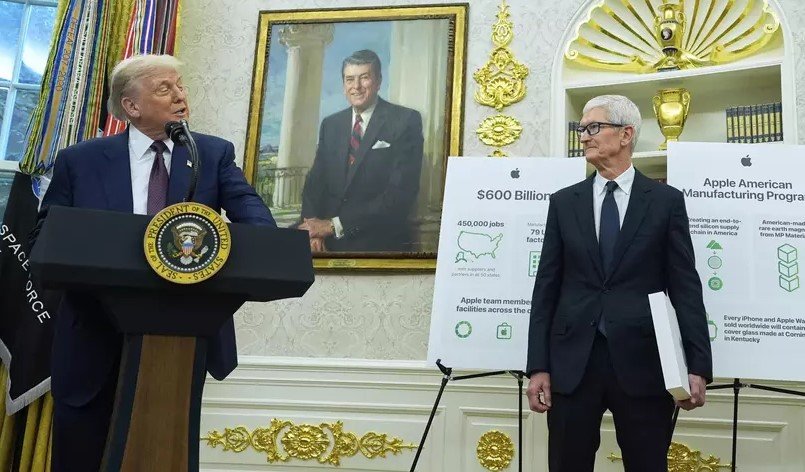Tech giant’s pledge pushes total U.S. commitment to $600 billion as it seeks tariff relief and deeper domestic roots
Apple’s shares shot up more than 5% on Wednesday after the iPhone maker pledged another $100 billion investment in the U.S., bolstering its manufacturing footprint and inching closer to sidestepping Trump’s looming tech tariffs. The announcement, made jointly with President Donald Trump, marked a rare harmony between the White House and Silicon Valley—and markets wasted no time cheering.
The latest move brings Apple’s total U.S. commitment to a staggering $600 billion, following its earlier pledge this year to pump $500 billion and create 20,000 American jobs by 2029.
Apple Stock Pops, Nasdaq Follows
Shares of Apple closed at $213.28, up 5.10% on the day. It was the stock’s biggest single-session gain in nearly four months. The broader Nasdaq Composite wasn’t left behind either—it climbed 1.21%, led by Apple’s outsized rally.
Investors saw the investment as more than just patriotic branding. It’s a calculated hedge against the trade war clouds gathering over the tech sector, especially with Trump threatening 25% tariffs on overseas-made Apple devices just weeks ago.
One-sentence paragraph? Let’s go: The iPhone just became a political football again.
Here’s what stood out on trading desks:
• Apple’s market cap gained nearly $170 billion in one session
• Options trading volume on AAPL surged, with call options dominating
• Semiconductor and advanced glassmakers with U.S. plants also saw upticks
Clearly, markets liked what they heard.

Trump Pitches It As a Win, Cook Keeps It Cautious
Speaking to reporters from the Oval Office, Trump said: “Companies like Apple, they’re coming home. They’re all coming home.” That line may have been aimed more at voters than Wall Street, but it resonated with both.
Right beside him stood Apple CEO Tim Cook, who handed Trump a 24-karat gold–based souvenir made in the U.S.—a visual prop, and maybe a diplomatic shield.
Cook didn’t exactly echo Trump’s optimism word-for-word. He reminded reporters that while many iPhone parts—like chips, Face ID modules, and specialty glass—are already made domestically, final assembly still happens overseas. And that’s not changing “for a while,” he said.
That caveat didn’t go unnoticed.
Short paragraph break: Cook’s walking a tightrope between appeasing D.C. and keeping his supply chain nimble.
Still, Apple’s new investment will reportedly go into expanding chip production, materials sourcing, and U.S.-based assembly partnerships. Details are scant for now, but insiders say it could include new facilities in Texas, North Carolina, and possibly Arizona.
Why This Matters More Than Just One Company’s Stock
Apple isn’t just any company. When it moves, markets ripple. When it speaks, other corporations listen. And when it pledges $600 billion, politicians from both parties take notes.
This is Apple’s third major public investment announcement since Trump’s re-election push picked up steam. The stakes are rising.
For many watching from Capitol Hill, this might signal a broader trend: large U.S. tech firms rethinking their global production strategies in favor of tariff-safe, politically strategic moves.
Here’s how Apple’s U.S. investment commitment has stacked up over the years:
| Year | Investment Pledged | Jobs Promised | Key Focus Areas |
|---|---|---|---|
| 2023 | $250 billion | 10,000 | Chip design, clean energy, R&D hubs |
| 2025 (Jan) | $500 billion | 20,000 | Supply chain, AI infrastructure |
| 2025 (Aug) | +$100 billion | TBD | Domestic manufacturing, job expansion |
This table tells you something: Apple’s not just reacting—it’s repositioning.
The Tariff Threat Still Lurks, Though
Despite the euphoria, the shadow of tariffs still hangs over Apple. Back in May, Trump threatened a blanket 25% tariff on Apple products assembled abroad—a move that could’ve jacked up iPhone prices by $100 or more.
Cook’s investment announcement could be a strategic play to dodge that bullet. And maybe buy time.
Still, there’s no official White House exemption for Apple yet. Trump’s team says companies that “build in the U.S.” will be spared, but that term is still undefined.
Short one-liner: Nobody knows how much “building” is enough.
With final iPhone assembly still happening in China, Apple may be walking a legal gray zone unless further supply chain changes are made. And with new iPhones expected this fall, clarity on tariffs may determine whether prices go up—or not.
Wall Street Cheers, But Questions Remain
Markets have a short memory and a long appetite for good news. Apple’s big splash was enough to send tech indices higher and give a brief reprieve from inflation and rate hike chatter.
But analysts aren’t fully sold on the story just yet.
A few questions floating around trading desks:
• Will this shift truly bring iPhone assembly stateside, or just peripheral expansion?
• How sustainable is this investment scale?
• And is it enough to keep regulators off Apple’s back through 2026?
Many believe Apple’s move is smart business wrapped in political theater. But the bigger risk may be global. If China perceives this shift as anti-Beijing, it could retaliate in kind — either with regulatory pressures or consumer backlash in its massive domestic market.
And for now, Cook seems aware of that tightrope.
